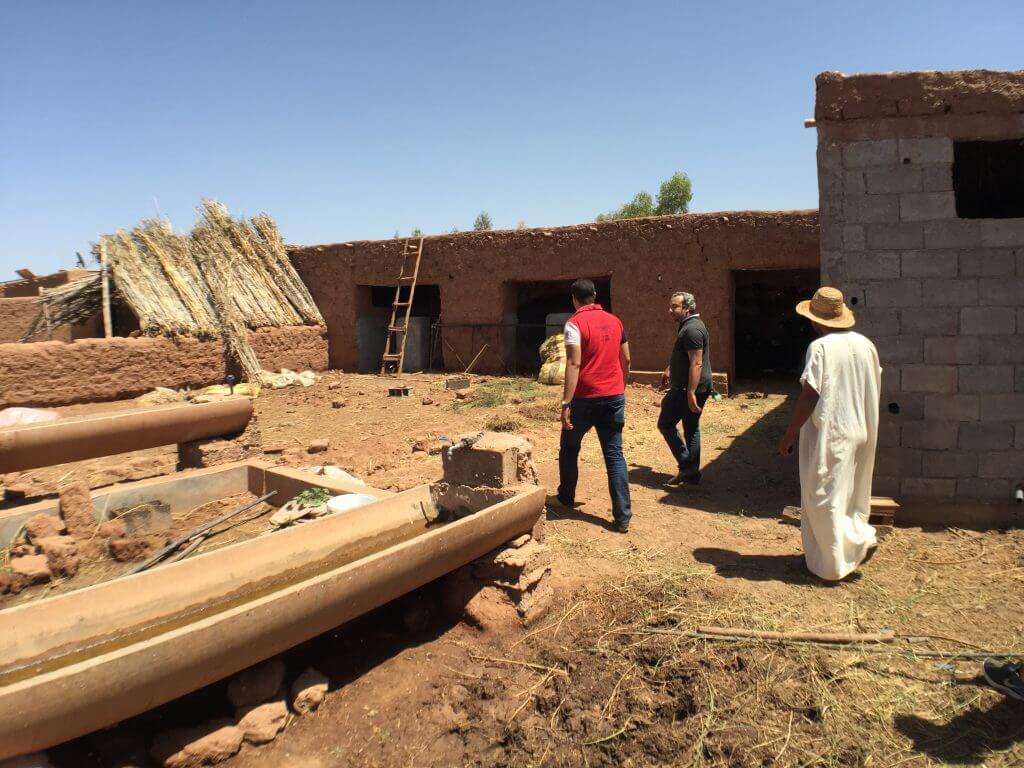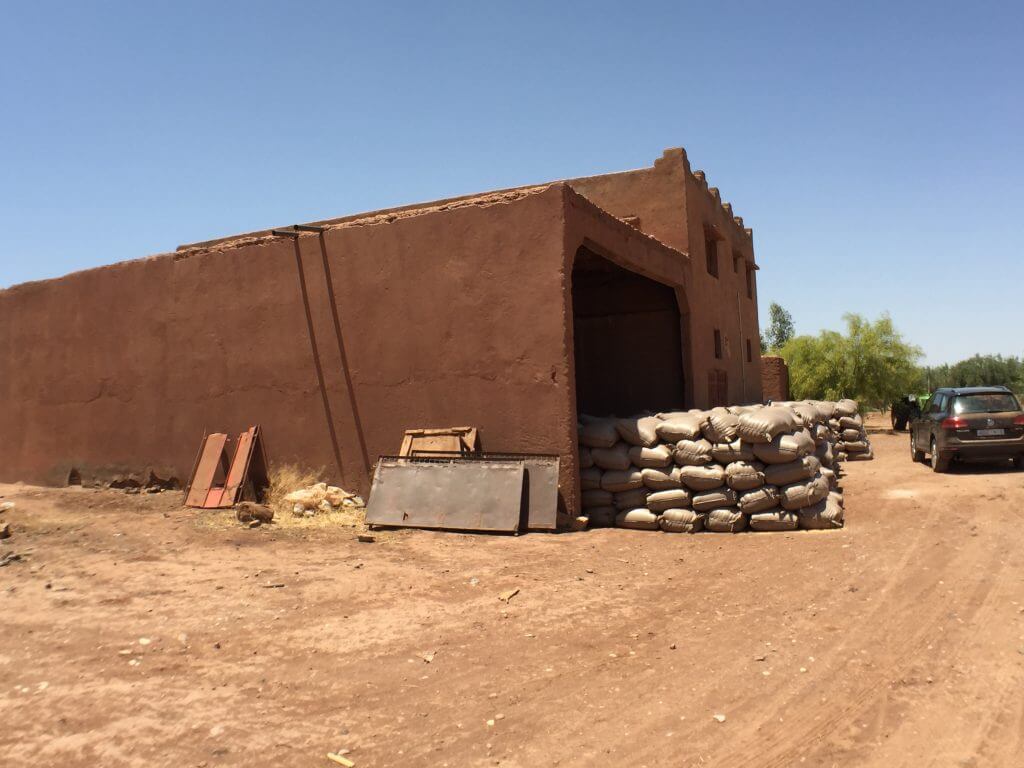I recently had the opportunity to visit some farms and distilleries in France and Morocco. I took Paul, Plant Therapy’s Vice President, and my 12-year-old daughter, Alexa, with me. In my last blog post I was able to share some photos of our visit to France. When we left France, we headed directly to Morocco (northern Africa).
We saw the following oil producing plants there:
- Rosemary
- Oregano
- Melissa (Lemon Balm)
- Bergamot
- Neroli
- Sweet Orange
- Lemon
- Lime
- Blue Tansy
- Chamomile
- Cedarwood Atlas
- Eucalyptus
- Eucalyptus Lemon
- Juniper
- Petitgrain
- Rose
We were mainly in search of two plants- one of which was Blue Tansy. As you may be aware, Blue Tansy has become more scarce over the past couple of years. In fact, the cost has gone from around $70 per kg four years ago, up to thousands of dollars per kg today. There are a number of reasons for this but all of it comes down to supply and demand. Because the plant has only been wild harvested in the past, as opposed to commercially farmed, it is becoming less abundant. We were getting ready to sign a large contract with a distillery in Morocco and I thought it best to pay them a visit before doing so.
We flew into Casablanca early in the morning and our host was waiting for us at the airport. Then, we immediately started driving to where the Blue Tansy plant is growing in the wild. In fact, over the course of the next few days, we drove over 2,000 miles visiting farms, countryside and distilleries.
I hadn’t done much research on Morocco and was a little surprised to find it to be an Arabic speaking country. Most of the street signs were in Arabic, although some were also in French.
It was also during Ramadan and since Morocco is 99.9% Muslim, it was a little difficult to find food during the day.
We arrived later in the day and made our first stop at their little distillery. This was much different than the state of the art distilleries in France.
This was a cooperative building. They have a small “test” garden where they are growing miscellaneous crops and testing their efficacy, oil yield, etc. This is done in cooperation with the local school.
In one part of the building they were drying and separating some flowers for use in tea.
In another room, they were distilling Blue Tansy that they had recently purchased from the ladies who picked them in the wild.
Out back they had some homemade greenhouses that they were trying to cultivate some Blue Tansy plants in.
When they are successful, they will move the small plants out to their farm to produce on a larger scale. They also had a fairly large Blue Tansy plant on site.
Did you know that the Blue Tansy plant doesn’t actually have any blue color to it? The plant itself has long stems with “hairy” leaves.
If it grows late into the season it will flower with some small yellow flowers and seeds.
It is interesting to watch a lighter green plant go into the still and a dark blue oil come out. I find it kind of humorous that almost all of the pictures posted online of the “blue tansy” plant are not of the correct plant. When we have asked a couple of reputable people about the photos they have posted, the response was that they have never actually been to Morocco or seen the Blue Tansy plant. They were just posting a photo they found online. I have never talked with any other essential oil supplier that has actually gone to Morocco to see the plant and see the process.
We continued our trip going further north into the hills. (They called them mountains, but growing up around the Rocky Mountains, I can’t really call them that.) Along the rural roadways we passed many women who were standing on the sides of the road selling their artisan goat cheese. We also saw people walking with their donkeys (or mules) or working the field with their horses.
When we stopped, I was fully expecting to see lots of wild Blue Tansy on the hillside. This was not the case. It was more like a small weed here and there. As we walked through the weeds they would point out a plant here or a plant there and say that was it.
When we rubbed our hands on the plant, the smell was all the proof I needed. It was pungent and obvious. The process for harvesting is that the local people will take their donkey with baskets attached, up into the hills and just pick plant by plant. They will then take their goods down to the roadway at a specified time to meet the distiller’s trucks. They pay them so much per kg of plant material. The competition has become high. There are 3-4 of these distillers competing for the same plants. As the plants become more scarce, the prices go up. It used to be that this plant was growing all over the place, but as the demand increases the availability has gone down.
To distill the Blue Tansy, this company will take 500 kg of fresh plant material and distill it at low heat for approximately 3 hours. This is a no pressure steam distillation. This will yield an average of 400 grams (roughly 14 ounces) of essential oil. They are still refining the process and I expect their yields to go up over the next 2-3 years. Although their batches are fairly small, their quality is excellent. Over the past couple of years, the Blue Tansy on the market has had a chamazulene (the active constituent that gives it the dark blue color) content ranging from roughly 3-8%. This year we have been purchasing Blue Tansy, both conventional and organic, with a chamazulene content above 10% with most batches up into the teens. I am both excited and encouraged by this, and I think you will love the Blue Tansy this year!
While up in the hills, we visited their second distillation site.
This one is outdoors. They have a hand dug, fresh water well on site.
They install the distillation equipment during the harvest season and remove it afterward. It is up for around 3 months out of the year.
We continued to the East and stayed at an incredibly beautiful hotel in M’diq. Most of the people who vacation in this area are Moroccans. Because the people do not generally vacation during Ramadan, the hotel was mostly vacant and it was very inexpensive. Due to the long travel days, Alexa was getting burned out and started getting sick.
We decided to take a day off and let her relax at the hotel. It was great to relax, swim in the ocean, and play some tennis to recharge.
We then continued on to Marrakech. This is a beautiful city. It was interesting to see lots of donkeys and scooters in use.
It was not uncommon to see a nicer vehicle in one lane and a donkey and wagon in the next. Also there were many women wearing burqas riding scooters. I was told that is an unusual thing and is generally only seen in Marrakech. It was a fascinating town and I really enjoyed learning about their culture a little bit. We asked lots of questions and our hosts were eager to answer.
After traveling many miles out to the countryside we visited some farms.
I was under the impression that this company had many acres in Blue Tansy planted. That was not the case. They were just starting the commercial operation and only had a few plants planted in test sites.
Most of the farm land was covered in grain or olive trees. Lots and lots of olive trees. The specific farm we visited has been in their family for over 500 years. It used to be massive but has split with each generation. It is still a decent size at over 350 acres.
I asked if the women received the same inheritance as the men and he said yes and no. He was very quick to point out that in Morocco women are seen and treated as equals. But their God’s law is that the men get two portions while the women get one. So this man has two sisters. His father split their family farm into two pieces. The two daughters split one half and the son got the other. He said he doesn’t like that, but it is the law so they honor it. It was also interesting to note that if a son inherits land and then dies before his father, the father receives 20% of the land back and 80% is passed on to his wife and kids.
The barn was made of clay and straw. It takes quite a while to build. They are made into bricks that are 40 cm thick and stacked to make walls.
It was built 13 years ago and he said it should be good for another 20 years or so. Because of Ramadan, the workers do not eat or drink during the day. They are working in the heat and easily get fatigued. They will work for a couple of hours then nap in the barn and continue this all day and into the night.
During harvest they will generally just sleep out on the farm. The water ditches are above ground. The water is pumped from a lake that is many miles away. There is one main pump and they just open valves to deliver it to the proper location.
Although many of the local farmers still use a scythe, this particular farm had a combine for harvesting grain- they will just bag the grain as they harvest and dump the bags in the field for retrieval later.
This is different than our Idaho grain operations which will collect the grain in the combine and deliver it in bulk to the grain bins. The grain bags weigh close to 250 lbs and they will just hand load them all onto trucks. He said when they are feeling competitive they will load two at a time- one on each shoulder. So that is almost 500 lbs by hand!
We spent the next couple of days in search of the Argan tree fruit. I will post photos and information about that in my next blog post.
Chris Jones
Plant Therapy









































